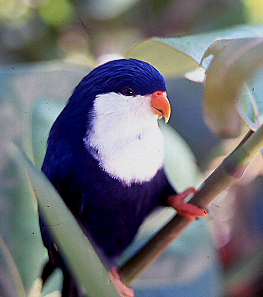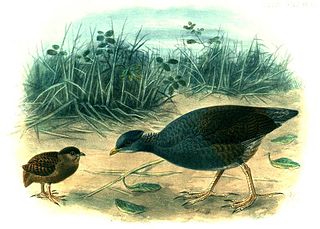
The rails, or Rallidae, are a large cosmopolitan family of small- to medium-sized, ground-living birds. The family exhibits considerable diversity and includes the crakes, coots, and gallinules. Many species are associated with wetlands, although the family is found in every terrestrial habitat except dry deserts, polar regions, and alpine areas above the snow line. Members of the Rallidae occur on every continent except Antarctica. Numerous island species are known. The most common rail habitats are marshland and dense forest. They are especially fond of dense vegetation.

Gallirallus is a genus of rails that live in the Australasian-Pacific region. The genus is characterised by an ability to colonise relatively small and isolated islands and thereafter to evolve flightless forms, many of which became extinct following Polynesian settlement.

The blue lorikeet is a small lorikeet from French Polynesia and the Cook Islands. It is also known as the Tahiti lorikeet, violet lorikeet, Tahitian lory, blue lory, nunbird, and the indigo lory. It was formerly found on 23 islands around Tahiti, but now restricted to perhaps eight islands: Motu, Manuae, Tikehau, Rangiroa, Aratua, Kaukura, Apataki, Aitutaki, and possibly Harvey Island and Manihi. Its plumage is mainly dark blue and it has a white area over its upper chest, throat and face. The first captive breeding in the UK was by the Marquess of Tavistock in the 1930s. He was awarded a silver medal by the Foreign Bird League for this achievement.

The conquered lorikeet is a species of parrot that became extinct 700–1300 years ago. It lived in islands of Polynesia. David Steadman and Marie Zarriello wrote its species description in 1987.

The Tongan megapode is a species of bird in the megapode family, Megapodiidae, currently endemic to Tonga. The species is also known as the Polynesian megapode, and as the Niuafo'ou megapode after the island of Niuafo'ou to which it was restricted for many years. The specific epithet honours British consul William Thomas Pritchard.

Vini is a genus of birds in the family Psittaculidae that are endemic to the islands of the tropical Pacific. There are eleven extant species of these small lorikeets ranging from eastern Fiji through Samoa, French Polynesia, and as far east as Henderson Island. All members of the genus have exceptional bright plumage, particularly the unusual all over blues of the blue lorikeet and the ultramarine lorikeet.
The Huahine starling is an extinct bird from the genus Aplonis within the starling family, Sturnidae. It was endemic to the island of Huahine, in the Society Islands of French Polynesia, and therefore had the easternmost distribution of all Aplonis species in the Pacific region.
The Huahine swamphen was a species of bird in the family Rallidae. It was a small swamphen endemic to Huahine in the Society Islands of French Polynesia. It is known only from subfossil remains found at the Fa'ahia archaeological site on the island. Fa'ahia is an early Polynesian occupation site with radiocarbon dates ranging from 700 CE to 1200 CE. The swamphen is only one of a suite of birds found at the site which became extinct either locally or globally following human occupation of the island.
The Huahine rail was a species of bird in the family Rallidae. It was a medium-sized Gallirallus rail endemic to Huahine in the Society Islands of French Polynesia. It is known only from subfossil remains found at the Fa'ahia archaeological site on the island. Fa'ahia is an early Polynesian occupation site with radiocarbon dates ranging from 700 CE to 1200 CE. The rail is only one of a suite of birds found at the site which became extinct either locally or globally following human occupation of the island.

Fa'ahia is an early Polynesian occupation site in the north-east of the island of Huahine, in the Society Islands, French Polynesia. With the neighbouring Vaito'otia site, it dates to between 700 CE and 1200 CE. Because much of the site is waterlogged, artefacts made of organic materials have been well preserved, including wooden patu hand clubs, canoe parts and adze handles.
The Huahine cuckoo-dove is an extinct species of bird in the family Columbidae. It was endemic to French Polynesia where subfossil bones between 750 and 1250 years old have been found at the Fa'ahia early occupation site on Huahine in the Society Islands.
Yosihiko H. Sinoto was a Japanese-born American anthropologist at the Bishop Museum in Honolulu, Hawaii. He is known for his anthropological expeditions throughout the Pacific, particularly Hawaii and French Polynesia.
The Huahine gull, also known as the Society Islands gull, is an extinct bird, a species of gull of which subfossil bones were found at the Fa'ahia archeological site on Huahine, in the Society Islands of French Polynesia.
The Tahuata rail is an extinct species of flightless bird in the Rallidae, or rail family.
The Ua Huka rail is an extinct species of flightless bird in the Rallidae, or rail family.
The Nuku Hiva rail is an extinct species of flightless bird in the Rallidae, or rail family.

The ʻEua rail is an extinct species of flightless bird in the Rallidae, or rail family. It was described in 2005 from subfossil bones found on the island of ʻEua, in the Kingdom of Tonga of West Polynesia.
The Marquesas cuckoo-dove, also referred to as the Marquesan cuckoo-dove, is an extinct species of bird in the pigeon family. It was endemic to the Marquesas Islands of French Polynesia. It was described from subfossil bones recovered from the Hane archaeological site on the island of Ua Huka. The cuckoo-dove was a relatively large species, with long legs; its limb proportions suggesting a more terrestrial lifestyle than its congeners. The dove's extinction occurred either upon or shortly after the colonisation of the islands by ancient Polynesians.

Hane is the largest settlement on the island of Ua Huka, in the Marquesas Islands of French Polynesia. Hane, a notable archaeological site, has a smaller population than the capital of Vaipae'e.








